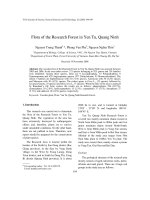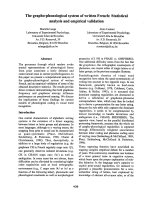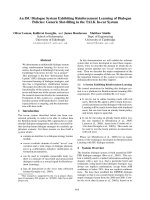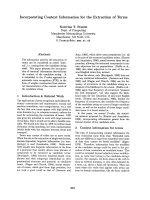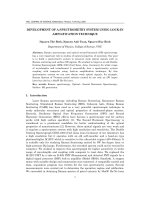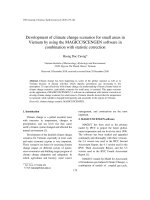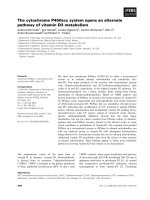Báo cáo "DEVELOPMENT OF HANOI BUS INFORMATION SYSTEM " pot
Bạn đang xem bản rút gọn của tài liệu. Xem và tải ngay bản đầy đủ của tài liệu tại đây (3.81 MB, 12 trang )
VNU JOURNAL OF SCIENCE, Earth sciences, T.xxIII, N
0
1, 2007
17
DEVELOPMENT OF HANOI BUS INFORMATION SYSTEM
Tran Quoc Binh, Le Phuong Thuy
College of Science, VNU
ABSTRACT. Public transport is a part of the contemporary urban model. In Vietnam, the
bus system is re-established a few years ago. At the same time, some maps have been
published for helping the bus passengers. But these maps are still lacked of rich contents
and useful functionalities.
With the aim to improving the effectiveness of Hanoi public transport system, the authors
have applied GIS technology for developing an information system of Hanoi bus. A logical
model of the bus network consisting of 2 sub-networks and 5 cost attributes has been
designed. This model serves as a basis for developing a bus geodatabase with 5 feature
classes. For managing the geodatabase, a set of tools extending the capabilities of ArcGIS
software via COM (Component Object Model) interface has been created.
The developed information system has very useful functionalities: supplying information
about bus stop and bus lines with illustrated photos, searching for streets and specific
objects, finding the fastest path by bus between places in the city, These functionalities will
help the bus passengers, especially those in the city for the first time, to be orientated in the
complicated Hanoi bus network.
1. Introduction
The rapid development of Geographic Information System (GIS) technology in
the past decade exerts strong influence on many socio-economic fields, including the
public transport field. Thus, GIS is widely used for modeling traffic in urban transport
network (Goh, 1993; Hossain and McDonald, 1998), for creating a road accident database
(Lupton and Bolsdon, 1999) and an expert system supporting public transport
management (Mackett and Edwards, 1996). For building enterprise-wide transportation
data repository, the Virginia Department of Transportation (VDOT) has developed the so
called Unified Network Transportation Data Model (UNETRANS) (Widner and Bucher,
2005). Recently, the Hong Kong's Bus Company established their own bus information
system based on ArcGIS technology (Baumann, 2004). Moreover, the governments of
the world largest cities (Paris, Seoul, ) also maintain electronic maps of their public
transport systems
1
.
Hanoi - the capital and the second largest city of Vietnam - is experiencing
difficulty in solving public transport problems for many years. Recently, with the help
of the European Union, the City has partly resolved this problem by re-establishing the
public bus system. Today, the Hanoi bus system has 55 lines and serves over million
passengers daily. The large number of bus lines, along with the maze-like street
1
These maps are available at addresses o/orienter/cv/cv_en/cartebus.php, and
Tran Quoc Binh, Le Phuong Thuy
18
system in the center area of Hanoi, can make headache for passengers, event if they
are the native Hanoians. Some efforts for helping passengers to be orientated in the
complicated bus network was made by Hanoi Transportation Corporation (Transerco)
in publishing an electronic map of Hanoi bus system
2
, but this map is still lacking of
many useful information, for example, the detailed information about bus stops, or
travel time, etc.
Being aware of problems of Hanoi bus passengers, the authors has conducted
research on creation of logical and physical models of a bus network, and on this basis
developed an information system of Hanoi bus (HBIS) by using ArcGIS software.
2. The network dataset concept
According to ESRI (Environmental Systems Research Institute Inc.) (ESRI,
2005a and 2005b), a network in general consists of: network elements, network
attributes, and network connectivity.
Network elements are the main components that make a network dataset. There
are 3 kinds of network elements: edges, junctions, and turns. Edges are elements that
connect to other elements (junctions) and are the links over which resources flow.
Junctions connect edges and facilitate navigation from one edge to another. Turn
elements record information about movement between two or more edges.
Connectivity in a network dataset is based on geometric coincidences of line
endpoints, line vertices, and points and applying connectivity rules that was set as
properties of the network dataset. Connectivity in ArcGIS begins with the definition of
connectivity groups. A network element of one connectivity group can only connect to
others elements that belong to the same group. Each edge source is assigned to exactly
one connectivity group and each junction source can be assigned to one or more
connectivity groups. Junctions that are assigned to two or more connectivity groups are
the only way that edges in different connectivity groups can connect. Edges in the same
connectivity group can be made to connect in two ways, set by the connectivity policy
on the edge source. If the "Endpoint" policy is set then line features become edges
joining only at coincident endpoints. Otherwise, if "Any vertex" connectivity policy is
set then line features are split into multiple edges at coincident vertices.
Network attributes are properties of the network elements that control
traversability over the network. They have four basic properties: name, usage type,
units, and data type. The usage property specifies how the attribute will be used
during analyses, which is identified as either a cost, descriptor, restriction, or
hierarchy. Cost attributes are used to measure and model impedances, such as travel
2
This map is available at address
Development of Hanoi Bus Information System
19
time (e.g. transit time on a street) or demand (e.g. the volume of garbage picked up on a
street). Descriptors are attributes that describe characteristics of the network or its
elements. Restrictions are attributes for identifying "restricted" elements that cannot
be traversed. The last type of network attributes is hierarchy, which means the order
or grade assigned to network elements.
3. Logical model of a bus network
In practice, if a bus passenger wants to travel from place A to place B, he (she)
has to do as follows:
(1) Walk from A to the nearest bus stop;
(2) Wait for an appropriate bus;
(3) Take the bus and ride to a stop near place B;
(4) Get off the bus;
(5) Walk to the destination place B.
Thus, the total time
T
needed to get from A to B is defined as:
∑
=
=++++=
5
1
54321
i
i
ttttttT
,
where:
-
1
t is time needed for walking along streets from A to the nearest bus stop. This
time is estimated by dividing the distance to average walking speed (about 4 km/h).
-
2
t is waiting time for an appropriate bus. The passenger may get the bus
immediately or he may wait by maximum the interval between two consecutive buses
of the same line. Therefore, the average value of
2
t is a half of this interval.
-
3
t is time taken to ride from get-on to get-off bus stop. This time parameter is
determined experimentally.
-
4
t is time to get off the bus, it can be assumed to be equal zero.
-
5
t is time to walk along streets from the get-off bus stop to the destination place
B. This time is estimated similarly to
1
t .
It can be seen that for traveling from A to B, the passenger will have 2 types of
movement: walking on the streets and riding by bus. Consequently, the logical model of
a bus network consists of 2 network groups:
- A network group of bus lines, called "Group 1";
Tran Quoc Binh, Le Phuong Thuy
20
- A network group of streets for walking, called "Group 2".
The passenger can get on and get off only at the bus stops. Therefore, the bus
stops are junctions that connect the two above network groups (Figure 1).
Bus subnetwork
(Group 1)
Street subnetwork
(Group 2)
Get
-
on
Get
-
off
Virtual stop
(junction)
Bus stop (junction)
Street (edge)
Bus line
(edge)
A
B
Figure 1. Logical model of a bus network
For modeling get-on and get-off actions, the authors suggest to use the so called
"virtual" bus stops: the get-on action is modeled by going from "actual" (physical) to
"virtual" bus stop, and vice versa, the get-off action is equivalent to going from "virtual"
to "actual" bus stop. Therefore, the "virtual" bus stop can be considered as a bus door.
The lines connecting "actual" and "virtual" bus stops are belonging to the bus
subnetwork (Group 1).
4. Geodatabase design
The bus network geodatabase is created with a single feature dataset that
contains 5 feature classes. The design of these feature classes is shown in Table 1. Based
on the first 4 feature classes, a network dataset is built with 2 groups (or subnetworks):
- Group 1 models the bus subnetwork, is built from Bus_Line, Bus_Stop and
Virtual_Stop feature classes.
- Group 2 models the street subnetwork, is built from Street and Bus_Stop
feature classes.
Thus, the junctions created from Bus_Stop feature class are belonging to both of
groups and play role of connecting the bus and the street subnetworks.
Development of Hanoi Bus Information System
21
Table 1. Feature classes in the bus network database
Feature class
Geometry
type
Network
role
Attributes
Attribute data
type
Bus_line Line Edge
Bus_Number
Start_Stop
End_Stop
Forward_Time_NonPeak
Backward_Time_NonPeak
Forward_Time_Peak
Backward_Time_Peak
Get_On_Off
Ticket_Price
Shape_Length
Integer
Text
Text
Float
Float
Float
Float
Integer
Float
Double
Street Line Edge
Name
Walking_Speed
Shape_Length
Text
Float
Double
Bus_stop Point Junction
Name
Served_Bus_Lines
Address
Bus_Stop_Photo
Specific_Object_Photo
Text
Text
Text
Text
Text
Virtual_stop Point Junction
Name
Bus_Line
Text
Integer
Specific_
Object
Point -
Name
Address
Photo
Text
Text
Text
For modeling walking and bus traveling time, the system uses 5 cost attributes
as shown in Table 2. In this table, the first 4 attributes are time needed for riding by
bus from stop to stop along streets. If some of these streets are one-way, for example,
only forward direction is allowed, then the corresponding backward time attributes are
set to a very large value (this action is equivalent to setting a restriction attribute).
Note that get-on and get-off time (
2
t
and
4
t
) are modeled as time cost attributes of
lines interconnecting bus stops and virtual stops: get-on is forward and get-off is
backward time.
Table 2. Cost attributes of the bus network
Name Unit Data Format
Forward_Time_NonPeak minute Float
Backward_Time_NonPeak minute Float
Forward_Time_Peak minute Float
Backward_Time_Peak minute Float
Street_Length meter Float
Tran Quoc Binh, Le Phuong Thuy
22
The last cost attribute in Table 2 - Street_Length - is used for calculating walking
times
1
t
and
5
t
between the get-on/get-off bus stops and the start/destination places.
5. Data acquisition
The base map used in this work is a tourist map of Hanoi City published in 2004.
Since this map is in analogue form, it was scanned at 200dpi resolution and
georeferenced by coordinates of the map grids. Based on the georeferenced map, the
features described in Table 1 are digitized.
Attribute data and photos are collected in the field. The travel time attributes are
measured manually at appropriate time (peak and non-peak hours). The time intervals
between 2 consecutive buses for calculating
2
t
are taken from data of Hanoi
Transportation Corporation (Transerco).
6. Software development and system deployment
HBIS can be deployed as an application installed on personal computers or as an
internet service (users will access the system via web browsers). The first solution can
be implemented as a standalone application (required ArcGIS Engine) or as an
extension of ArcGIS Desktop software. The second, internet solution, required ArcGIS
Server with Network Analyst extension. Whatever solution is chosen, there is a need
for additional tool programming because standard ArcGIS functionality does not meet
all requirements of the system.
Thus, standard ArcGIS's Identify tool has limited capability in displaying images
and photos associated with the map features. For displaying photos of bus stops and
surrounding specific objects, the authors have developed a new identify tool called
BIdentify by using Borland Delphi 6.0 software. This tool was developed as a COM
(Component Object Model) server implementing 2 interfaces ICommand and ITool for
connecting to the main application (Fig. 2).
Arc
GIS
Desktop or
Server
(COM client)
BIdentify
(COM server)
ICommand
ITool
COM
Figure 2. BIdentify tool is developed as a COM server
When BIdentify is activated and the user clicks on the desired map feature, the
tool connects to an external database, if any, to query attribute data and displays it on
Development of Hanoi Bus Information System
23
the screen. If some fields contain paths to image files in database then BIdentify will
open them and display images instead of textual data.
For user's convenience, HBIS has ability to search for streets, bus lines, bus stops
and specific objects by their name (or number). This is actually the Search By Attribute
tool of ArcGIS, but its use is not easy for non-experienced user. Because of that, the
authors have developed another tool called StSearch, which implements the following
simple query:
SELECT *
FROM LayerName
WHERE [Name] = "FeatName"
where LayerName is the name of layer containing searched features, FeatName is the
name of these features. If the features are found, StSearch will display them on the
screen at desired scale. For communication with ArcGIS, StSearch is implemented as a
COM server in the same manner as BIdentify. Note that all of the software tools use
Unicode character set and thus the system can manage and display data in virtually
any language.
7. Test and discussion
For testing purpose, the system is deployed as an extension to ArcGIS desktop.
The users interact with the system via HBIS Toolbar with 6 buttons as shown in Fig. 3.
1
2
3
4
5
6
Figure 3. The HBIS toolbar
The buttons of HBIS toolbar have the following functions:
StSearch: searches for streets, bus lines, bus stops and specific objects by their
name;
BIdentify: shows information about features including their photos;
New Route: creates new route in order to perform fastest path analysis;
Network Location: defines start, destination and intermediate locations on the
map for preparing the fastest path analysis;
Solve: performs the fastest path analysis;
Direction: shows information about the fastest travel route.
Tran Quoc Binh, Le Phuong Thuy
24
For searching features by their name, the user clicks the StSearch button on
HBIS toolbar, in the displayed dialog box defines search mode (for streets, bus lines, )
and choose the name of searched feature. If the feature is found, the system zooms on it
at the maximum scale defined by the user. Figure 4 is an example of searching Dich
Vong Street.
Figure 4. Search for Dich Vong Street
When the object is found on the map, the user can display its attributes and
photos by choosing BIdentify tool and click on it. The system will display a dialog
box containing all information about object including its photos (Fig. 5).
Figure 5. Displaying information about Bach Mai Hospital bus stop
For searching the fastest path between places in the city, the user must create a
new route (button 3 on HBIS toolbar), choose time of traveling (peak or non-peak
Development of Hanoi Bus Information System
25
hours) in Route Properties dialog box, and then define traveling places on the map by
using Network Location tool (button 4 on HBIS toolbar). After clicking Solve button
, the fastest path will be shown on the map as well as the travel directions window.
Figure 6 is an example of finding the fastest path from 29 Dich Vong St. to Hanoi
University of Science at 334 Nguyen Trai Rd. at non-peak time (the first two time
values and the last one in the Directions window are walking time). Note that there are
numerous paths to travel by bus between these places (see Table 3), but the path
displayed on the map is the fastest one.
Figure 6. Finding the fastest path from 29 Dich Vong to HUS at 334
Nguyen Trai
Tran Quoc Binh, Le Phuong Thuy
26
Table 3. Some possible paths for traveling from 29 Dich Vong to 334 Nguyen Trai
Path name By bus lines Along streets
Travel time
(min)
Path length
(m)
B34/44 34, 44 Cau Giay, Pham Hung, , Nguyen Trai 55 9875
B35/21 35, 21 Cau Giay, , Thai Ha, Tay Son, , Nguyen Trai 51 8702
B16/27 16, 27 Cau Giay, Lang, Nguyen Trai 47 7491
B32/27 32, 27 Cau Giay, Kim Ma, ,Lang, Nguyen Trai 45 8376
The results in Table 3 show that the shortest path is B16/27, but the fastest one
is B32/27. At first look it seems inconsistent, but detailed analysis shows that the time
2
t
for waiting bus No 16 is much longer than that for bus No 32 (10 minutes against 5
minutes). Thus, path B32/27 is actually the fastest one.
For time accuracy assessment, the authors have made control travels along 2
tested routes and computed root mean square errors (RMSE). The results are shown in
Table 4. It can be seen that the average error of traveling time is about 3 minutes,
what is acceptable for most bus passengers.
Table 4. Accuracy assessment
Parameters
Route 29 Dich Vong -
334 Nguyen Trai
Route Bao Son Hotel - Thu Le Zoo - Ho
Tay Water Park
Fastest path
Bus 32 →
→→
→ 27 Bus 26 →
→→
→ 32 →
→→
→ 55
Time given by HBIS 45 min 58 min
Control travel No1 42 min 61 min
Control travel No2 47 min 56 min
Control travel No3 41 min -
RMSE 3.1 min 2.6 min
8. Conclusion
Public transport always is a difficult problem of big cities in Vietnam, especially
under pressure of the current intensive socio-economic development. There are existed
many solutions for this problem, among those the solution of using information
technology to gain the capability of current public transport system is a very effective
one.
In this work, the authors have applied GIS technology to develop a bus
information system for helping passengers to use the complicated bus network of Hanoi
City. By using the system, it is possible to obtain information about bus lines, bus
Development of Hanoi Bus Information System
27
stops, search for streets or specific objects by their names, and find the fastest path
between 2 or more places inside the city with an error of about 3 minutes. For
implementing these functionalities, the paper has developed a logical model of a bus
network consisting of 2 groups and 5 travel time parameters, and a bus geodatabase
with 5 feature classes. The data management tool is designed as COM servers to
extend standard functionality of ArcGIS software.
The future research will be focused on extending the system for other kinds of
urban transport (bicycle, motorcycle, ) and deploying on the internet for wider and
easier access.
References
[1] Baumann, J. (2004), GIS provides customer satisfaction for Hong Kong Bus Company,
Directions magazine, 12/2004 (Internet journal at www.directionsmag.com).
[2] ESRI (2005a), ArcGIS Geodatabase Workbooks, ESRI, Redlands, CA, USA, 262pp.
[3] ESRI (2005b), What is ArcGIS? ESRI, Redlands, CA, USA, 332 pp.
[4] Goh, P. C. (1993), Traffic analysis using geo-processing techniques, Road and Transport
Research, 2(2), pp.77-85.
[5] Hossain, M., McDonald, M. (1998), Modeling of traffic operations in urban networks of
developing countries: a computer aided simulation approach, Computer, Environment
and Urban Systems, Vol. 22, No. 5, pp. 465-483.
[6] Lupton, K., Bolsdon, D. (1999), An object-based approach to a road network definition for
an accident database, Computer, Environment and Urban Systems, Vol. 23, pp. 465-483.
[7] Mackett, R., Edwards, M. (1996), An expert system to advise on urban public transport
technologies, Computer, Environment and Urban Systems, Vol. 20, No. 4/5, pp. 261-273.
[8] Widner, D., Bucher, P. (2005), DOT develops robust enterprise geospatial repository,
ArcUser, 10-12/2005, pp. 28-31.
VNU JOURNAL OF SCIENCE, Earth sciences, T.xxIII, N
0
1, 2007
17
